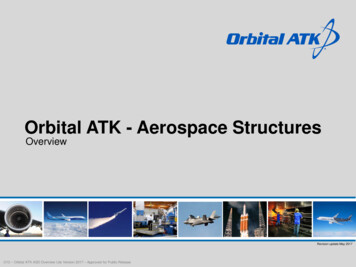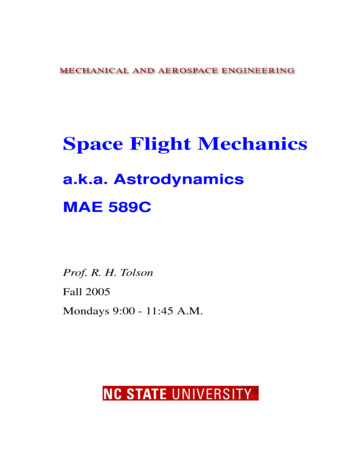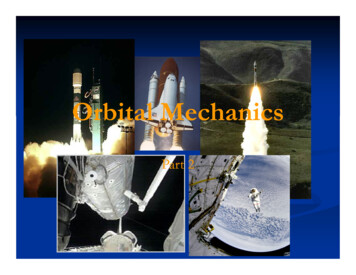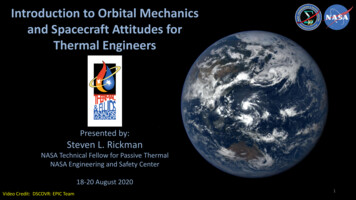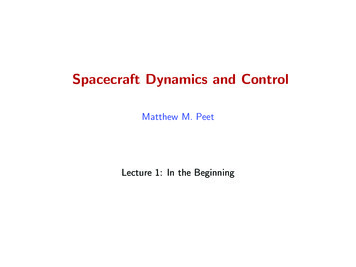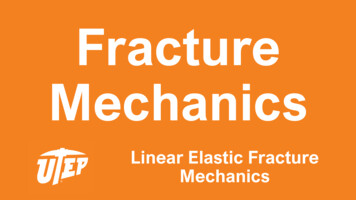
Transcription
Orbital Mechanics Course NotesDavid J. WestpfahlProfessor of Astrophysics,New Mexico Institute of Mining and TechnologyMarch 31, 2011
2These are notes for a course in orbital mechanics catalogued as AerospaceEngineering 313 at New Mexico Tech and Aerospace Engineering 362 atNew Mexico State University. This course uses the text “Fundamentals ofAstrodynamics” by R.R. Bate, D. D. Muller, and J. E. White, published byDover Publications, New York, copyright 1971. The notes do not follow thebook exclusively. Additional material is included when I believe that it isneeded for clarity, understanding, historical perspective, or personal whim.We will cover the material recommended by the authors for a one-semestercourse: all of Chapter 1, sections 2.1 to 2.7 and 2.13 to 2.15 of Chapter 2,all of Chapter 3, sections 4.1 to 4.5 of Chapter 4, and as much of Chapters6, 7, and 8 as time allows.PurposeThe purpose of this course is to provide an introduction to orbital mechanics. Students who complete the course successfully will be prepared toparticipate in basic space mission planning. By basic mission planning Imean the planning done with closed-form calculations and a calculator. Students will have to master additional material on numerical orbit calculationbefore they will be able to participate in detailed mission planning.There is a lot of unfamiliar material to be mastered in this course. Thisis one field of human endeavor where engineering meets astronomy and celestial mechanics, two fields not usually included in an engineering curriculum. Much of the material that is familiar to students of those disciplineswill be unfamiliar to engineers. Students are probably already familiar withNewton’s Laws and Newtonian gravity. These will be used to develop theparticular applications needed to describe orbits and orbital maneuvers.Space missions are expensive and risky, especially if people or living animals are sent into space. Thus, it is important to check and recheck calculations and assumptions. Computer programs are subject to the imperfectionsof the humans who write them. This, it becomes necessary to develop physical insight into orbit calculations to have a sense of when a programmingbug is leading to inaccurate answers. We will spend time developing physicalintuition and understanding what it is.NotationWell I remember being a student and being frustrated by notation usedby printers of textbooks that was impossible to write by hand at note-takingspeed, and not used by the professor, anyway. Thus, I have tried to use
3notation that is consistent with the text, but also within my abilities to writeon the board and within the abilities of students to write in their notes. Someexamples follow.A scalar is written as an ordinary math symbol, as in a.A vector is written with an arrow above, as in r.A unit vector is written with a hat, as in r̂. If the unit vector is a basis vectorˆof a coordinate set it’s symbol is usually capitalized, as in I.A matrix is written in a boldfaced capital letter and covered by a tilde, asin D̃. This is a compromise. The tilde is easy enough to write in notes oron the board, but boldface is not. The boldface is used to make the matrixinstantly recognizable in the notes, at the cost of inconsistency.The inverse of the same matrix is written as D̃ 1 .The transpose of a matrix is written in boldface with a tilde and a trailingsuperscript capital T, as in D̃T .A triangle with vertices A, B, and C is named ABC. Its line segments arenamed AB, BC, and CA. Order does not matter, so AB and BA describethe same line segment. The angle between segments AB and BC is labeled[ABC.These notes were made using the LaTeX math symbols of AMS TeX.Anyone who has posted hundreds of pages of LaTeX notes has probablydiscovered hundreds of typos and left undiscovered scores of others. I amno exception. If you discover typos please report them to me by email atdwestpfa@nmt.edu.D. J. W.Albuquerque, NMJanuary, 2011
4
Contents1 Two-Body Orbital Mechanics1.1 Kepler’s Laws . . . . . . . . . . . . . . . . . . . . . . . . . . .1.2 Newton’s Laws . . . . . . . . . . . . . . . . . . . . . . . . . .1.2.1 An Example . . . . . . . . . . . . . . . . . . . . . . . .1.2.2 History . . . . . . . . . . . . . . . . . . . . . . . . . . .1.3 The Equation of Motion for Two Orbiting Bodies . . . . . . .1.3.1 Choosing a Goal . . . . . . . . . . . . . . . . . . . . .1.3.2 Making Things Complicated . . . . . . . . . . . . . . .1.3.3 Making Things Simple Again . . . . . . . . . . . . . .1.4 Partial Solutions of the Equation of Motion . . . . . . . . . .1.4.1 Constants of the Motion . . . . . . . . . . . . . . . . .1.4.2 The Trajectory Equation . . . . . . . . . . . . . . . . .1.5 Conic Sections . . . . . . . . . . . . . . . . . . . . . . . . . . .1.5.1 Polar Equations of Conics . . . . . . . . . . . . . . . .1.6 Properties of Conic-Section Orbits . . . . . . . . . . . . . . . .1.6.1 Relating the Constants of the Motion to the Geometryof the Orbit . . . . . . . . . . . . . . . . . . . . . . . .1.6.2 Some Important Properties of Individual Conic Orbits1.6.3 Relationships Among the Conics . . . . . . . . . . . . . . . . . . . . . . . . . . . . . . . . . . . . .1.6.4 What is B?1.6.5 The Eccentricity Vector . . . . . . . . . . . . . . . . .1.7 Canonical Units . . . . . . . . . . . . . . . . . . . . . . . . . .2627303234342 Orbit Determination from Observations2.1 Coordinate Systems . . . . . . . . . . . . . . . .2.1.1 Heliocentric-Ecliptic Coordinates . . . .2.1.2 Geocentric-Equatorial Coordinates . . .2.1.3 Right Ascension-Declination Coordinates39394041415.11248991010141417181924
6CONTENTS2.22.32.42.52.62.72.82.1.4 Perifocal Coordinates . . . . . . . . . . . .Classical Orbital Elements . . . . . . . . . . . . .Determining the Orbital Elements from r and v .2.3.1 Three Fundamental Vectors . . . . . . . .2.3.2 Solving for the Orbital Elements . . . . . .Determining r and v from the Orbital Elements .Coordinate Transformations . . . . . . . . . . . .2.5.1 Transformations Change the Basis Vectors2.5.2 Simple Transformations . . . . . . . . . .2.5.3 More Challenging Transformations . . . .Mechanics on the Rotating Earth . . . . . . . . .2.6.1 An Introduction to Time . . . . . . . . . .2.6.2 Position, Velocity, and Acceleration . . . .The Ellipsoidal Earth . . . . . . . . . . . . . . . .2.7.1 The Measurement of Latitude . . . . . . .2.7.2 Station Coordinates . . . . . . . . . . . . .The Ground Track of a Satellite . . . . . . . . . .2.8.1 Launch Site, Launch Azimuth, and Orbital. . . . . . . . . . . . . . . . . . . . . . . . . . . . . . . . . . . . . . . . . . . . . . . . . . . . . . . . . . . . . . . . . . . . . . . . . . . . . . . . . . . . . . . . . . . . . . . . . . . . . . .Inclination3 Real Orbits and Orbital Maneuvers3.1 Some Types of Orbits . . . . . . . . . . . . . . . . . .3.1.1 Classification of Earth Orbit by Altitude . . .3.1.2 Classification of Orbits by Inclination . . . . .3.1.3 Sun-Synchronous Orbits . . . . . . . . . . . .3.1.4 Special Orbits . . . . . . . . . . . . . . . . . .3.2 The Earth’s Equatorial Bulge . . . . . . . . . . . . .3.3 In-Plane Orbit Changes . . . . . . . . . . . . . . . .3.3.1 Launching a Satellite and Adjusting its Orbit3.3.2 Hohmann Transfer . . . . . . . . . . . . . . .3.3.3 General Coplanar Transfer . . . . . . . . . . .3.4 Bi-elliptic Transfer . . . . . . . . . . . . . . . . . . .3.5 Out-Of-Plane Orbit Changes . . . . . . . . . . . . . .4 r and v as Functions of Time4.1 What we Have Done . . . . . . . . . . . . . . . . .4.2 Elliptical Time of Flight as a Function of E . . . .4.2.1 Two Approaches: Geometric and Analytical4.2.2 Why is This Integral so Difficult? . . . . . 3949496100106111.113. 113. 114. 114. 116
7CONTENTS4.2.34.34.4Kepler’s Geometric Method - Developing Kepler’s Equation . . . . . . . . . . . . . . . . . . . . . . . . . . . .4.2.4 Time of Flight Between Arbitrary Points . . . . . . . .4.2.5 Analytical Method . . . . . . . . . . . . . . . . . . . .Parabolic Time of Flight as a Function of D . . . . . . . . . .Hyperbolic Time of Flight as a Function of F . . . . . . . . .4.4.1 Area as a Measure of Angle . . . . . . . . . . . . . . .4.4.2 Hyperbolic Time of Flight . . . . . . . . . . . . . . . .5 Orbit Determination from Two Positions and Time6 Ballistic Missile Trajectories6.1 History . . . . . . . . . . . . . . . . . . . .6.2 Purpose . . . . . . . . . . . . . . . . . . .6.3 Basics of Ballistic Missiles . . . . . . . . .6.3.1 The Non-dimensional Parameter, Q6.3.2 The Free-Flight Range Equation . .6.3.3 The Flight-Path Angle equation . .117121123125127127131137.1391391401401411411427 Lunar Trajectories1457.1 Sphere of Influence . . . . . . . . . . . . . . . . . . . . . . . . 1457.2 The Patched Conic Approximation . . . . . . . . . . . . . . . 1468 Interplanetary Trajectories147
8CONTENTS
Chapter 1Two-Body Orbital MechanicsA story has to start somewhere. Our story starts with Kepler’s Laws.1.1Kepler’s LawsFollowing our text, Fundamentals of Astrodynamics by Bate, Mueller, andWhite, we start with Kepler’s Laws of Planetary Motion, which are generalizations derived from the planetary position data of Tycho Brahe. Accordingto our text, Kepler published the first two laws in 1609, and the third in 1619.Kepler’s LawsKepler’s First Law - The orbit of each planet is an ellipse with the Sun atone focus.Kepler’s Second Law - The line joining any planet to the Sun sweeps outequal areas in equal times.Kepler’s Third Law - The squares of the periods of any two planets are inthe same proportion as the cubes of their mean distances from the Sun.These laws explain what the orbits are. Their shapes are ellipses, and thelocal, instantaneous speeds within the ellipses change so that the second andthird laws are true. These laws do not explain why the shapes and speedsof the orbits behave in this way. Our first goal will be to apply the work ofNewton to understand why.1
21.2CHAPTER 1. TWO-BODY ORBITAL MECHANICSNewton’s LawsNewton did his fundamental work in the 1660’s, but did not publish untilthe Principia appeared in 1687. Without the help of Edmund Halley thePrincipia might never have seen the light of day. The Principia containsNewton’s three Laws of Motion and the Law of Universal Gravitation (moreon that later). You will find variations in the statements of the Laws ofMotion because the Principia is in Latin, and there is more than one Englishtranslation.Newton’s Laws of MotionNewton’s First Law - A body at rest stays at rest, and a body in motionstays in uniform, straight-line motion, unless acted upon by a net force.Newton’s Second Law - The time rate of change of momentum is proportional to the impressed force and is in the same direction as that force, ord p F tot .dtNewton’s Third Law - For every action there is an equal and oppositereaction, or, forces always come in pairs. If body A exerts a force on bodyB, then body B exerts a force on body A that is equal in magnitude andopposite in direction.The First Law corrects a fallacy in Aristotle’s physics, that the naturalstate of motion is rest. Newton says that the natural state of motion isstraight-line, uniform motion, that is, motion with constant linear momentum. Rest is a special case in which the momentum is zero. It is interestingthat most students naturally believe in Aristotle’s physics, even if they havenever heard of it. They work hard in Physics 121 to overcome this naturalbelief.The Second Law is effectively a definition of force from momentum, orfrom mass and acceleration. It explicitly involves the time rate of change, soit assumes that the reader is familiar with calculus. Let us remind ourselvesof the definition of momentum,p m v ,so thatwhere F totd(m v )d vdmd p m v F tot ,dtdtdtdtis the total force.
1.2. NEWTON’S LAWS3Force and momentum are vectors. This is not stated explicitly in theSecond Law, I have added that part. Newton does say that the directionof the momentum change and the impressed force are the same, implyinga vector relationship. The term impressed force is a bit vague, and someimpressed forces can be counteracted, at least partially, by friction, whichmay be passive. Some statements of the Second Law use the phrase net forceor unbalanced force, which may impart more clarity. The force that causesa change in momentum is one that is not counteracted or nullified by otherforces.The fact that forces are vectors is under appreciated, and its proof is tooeasily ignored. The statement that the time rate of change of momentumequals the total force implies a vector sum of forces.pThe fact that F , d , and m a are all vectors means that they can, and,dtin application, must, be resolved into components. In every application ofNewton’s Laws we will require ourselves to choose and explicitly state a coordinate system, unless there is a compelling reason not to. We will makefrequent use of Cartesian coordinates and spherical polar coordinates. Oneof our challenges will be to develop the definition of what a coordinate transformation is and what it does.The Third Law turns out to be the one that challenges students the most,even more than the First Law. This is because, while forces do come in pairs,the two forces act on different bodies. This must be fully understood beforethe Second Law is applied. We use free body diagrams as a bookkeepingtechnique to assure that the bodies on which the forces act are properlyassigned.We need to work at least one example, but first a reminder. Bodiesmay exert forces on themselves, but these forces do not cause a change inmomentum. Consider the classic example of pulling one’s self up by one’sbootstraps. If you pull up on your bootstraps, your bootstraps must pulldownward on you. By the Third Law these forces must be equal and opposite. So far, so good. Assuming that your boots do not rip apart and thatyour boots are are attached to your feet, the forces cancel and no change inmomentum results.When do forces result in change in momentum? Forces cause a changepin momentum when the total force or net force is nonzero, d 6 0 whendtF tot 6 0.Problem 1 The Third Law
4CHAPTER 1. TWO-BODY ORBITAL MECHANICSIf you cannot exert a net force on yourself how can you stand up fromyour chair at the end of class?1.2.1An ExampleAs an example, consider a very simple railroad train, consisting of one engine,one freight car, and one caboose. Let the train operate on a straight, leveltrack. We choose a two-dimensional coordinate system with x along the trackand y upward, perpendicular to the track. By convention we must choose aright-handed coordinate system, so let x be to the right. Let us assume thatthe train cars individually are of constant mass, so we know from the SecondLaw thatd p F m a.(1.1)dtThis is a vector equation, so a similar equation must apply in each coordinatedirection,Fx max ,(1.2)andFy may .(1.3)There is no motion in the z direction, so we may choose to ignore the application of the Second Law there. If we do apply the Second law to the zdirection the result is trivial because Fz 0 and az 0. Even with thissimplification we will see that a thorough analysis of the motion of the trainbecomes complex very rapidly.By convention, we draw a free-body diagram for each of the three railroadcars. The argument above shows that we need to be concerned with the xand y directions only. Consider the engine first. At least four forces acton the engine. Three are obvious - the engine’s weight due to gravity, theupward force of the track on the engine (in the y direction), and the forwardor backward force of friction of the track on the engine (in either the plusor minus x direction). The engine and track are in contact where the wheelstouch the track, so that is where the friction and the upward force act. Thefriction may be forward or backward according to what the engineer is doingwith the drive motor and the brakes. There must be some friction or thetrain could not move. Judicious application of the power of the drive motormust move the train forward, similar use of the brakes must slow it down.
51.2. NEWTON’S LAWSLet’s assume that the engineer is controlling the power so that the train ismoving forward.The fourth force is not so obvious. The engine exerts a force on thefreight car, thus pulling the freight car forward, so the freight car must exerta backward force on the engine according to the Third Law. This is thefourth force. Thus, the free-body diagram of the engine shows four forces:the weight downward, the track normal force upward, a frictional force fromthe track that is forward, and a backward force exerted by the freight car onthe engine.Next, consider the freight car. It, too, has four forces in its free-bodydiagram. There is still a weight downward and a track force upward. Theengine pulls the freight car forward. The freight car is attached to the caboose, and the freight car pulls the caboose forward, so by the Third Lawthe caboose must exert a backward force on the freight car. These are thefour forces. We could include a fifth force, the friction of the track on thecar, but we choose to ignore it.Finally, consider the caboose. It has only three forces in its free-bodydiagram, because it is not attached to anything behind it. There is still aweight, still a track force upward, and the force exerted by the freight car onthe caboose. Again, we choose to ignore friction.We have all watched or ridden in trains that operate on a track that isessentially straight and level. Such a train never sinks into the Earth or fliesupward from the track, so we infer that ay is always zero, or very nearly so.By application of the Second Law, this means that the sum of the forces inthe y direction must also be zero, so the weight of the engine and the upwardforce on the engine exerted by the track must be balanced - they must beequal and opposite, so their sum is zero. This conclusion applies to all of thecars in the train. It means that all of the interesting things that happen arein the x direction.Apply the Second Law to the engine using its free-body diagram as aguide. In the positive x direction we have the force of friction on the engine,fe . In the negative x direction we have the force of the freight car on theengine, Ff ce . The Second Law givesfe Ff ce me ae ,(1.4)where me is the mass of the engine and ae is its acceleration. An applicationof the Second Law such as this gives the equation of motion, in this case theequation of motion for the engine.
6CHAPTER 1. TWO-BODY ORBITAL MECHANICSSimilarly, apply the Second Law to the freight car to get its equation ofmotion,Fef c Fcf c mf c af c ,(1.5)where Fef c is the force of the engine on the freight car, Fcf c is the force of thecaboose on the freight car, mf c is the mass of the freight car, and af c is itsacceleration. Then apply the Second Law to the caboose to get its equationof motion,Ff cc mc ac ,(1.6)where Ff cc is the force of the freight car on the caboose, mc is the mass ofthe caboose, and ac is its acceleration.Taken together these three equations seem daunting; they certainly donot invite solution. They will, once they are simplified. First, note that thecars of the train are rigidly tied together by the couplers, so they must allhave the same acceleration,ae af c ac a.(1.7)Next, notice that by the Third Law the force exerted by the freight car onthe engine must be equal and opposite to the force exerted by the engineon the freight car. The directions have been accounted for in the free-bodydiagrams, so we need only concern ourselves with the magnitudes of theforces. We write Ff ce Fef c F1 . A similar application of the Third Lawshows that the force of the caboose on the freight car must be equal andopposite to the force of the freight car on the caboose. Again, direction hasbeen accounted for in the free-body diagrams, so the magnitudes of the forcesbecome Fcf c Ff cc F2 .With these simplifications we can rewrite the equations of motion. Theequation for the engine becomesfe F1 me a,(1.8)that of the freight car becomesF1 F2 mf c a,(1.9)and that of the caboose becomesF2 mc a.(1.10)
1.2. NEWTON’S LAWS7So far we are left with three equations in the four unknowns a, F1 , F2 , andff . If we can eliminate one of the unknowns then we can solve for the motionof the train. This is good. We know that real trains move, and we are gettingclose to understanding why.There are two obvious ways to proceed. One is to measure the accelerationof a real train and calculate the forces involved. The other is to measure thefriction and calculate the acceleration and the forces among the cars. Wechoose to measure the friction.In many situations the friction is well described by ff µN, where µis the coefficient of friction and N is the normal force. The coefficient offriction is taken to be a constant of order unity that depends on the natureof the materials that are in contact. The normal force is simply the upwardforce exerted by the track. In the case of the engine we have shown that itis merely the engine’s weight, or me g, where g is the acceleration of gravity,so ff µme g. We can plug this into the equation of motion for the engine,gettingµme g F1 me a.(1.11)This presents a strategy for solving for the motion of the train: solve thisequation for F1 , plug that into the equation of motion for the freight car andsolve for F2 . Plug that into the equation of motion for the caboose and solvefor a. The value of a can then be used to fine F1 and F2 . Proceeding withthe plan,F1 µme g me a me (µg a).(1.12)Plugging into the equation of motion for the freight car,µme g me a F2 mf c a,(1.13)F2 µme g me a mf c a µme g (me mf c )a.(1.14)and solving for F2 ,Plugging into the equation of motion for the caboose,µme g (me mf c )a mc a,(1.15)µme g (me mf c mc )a mtrain a.(1.16)or
8CHAPTER 1. TWO-BODY ORBITAL MECHANICSThis says that the friction between the engine and the track must be largeenough to accelerate the entire train! Amazing! Solving for the acceleration,a µme g,mtrain(1.17)which says that the acceleration is the friction force divided by the total massof the train. This makes sense. Note that if there is no freight car or caboose,so their masses are each zero, thena µme g µg,me(1.18)which may make sense based on your earlier studies.Notice how complicated and subtle this analysis is. Let’s take a look atwhat we have accomplished. We have calculated the motion of a train fromfirst principles using Newton’s Laws. At the beginning of the seventeenthcentury nobody was able to do this. By the end of the seventeenth centurythe most skillful mathematicians and natural philosophers were able to dothis. Trains were unknown at the time, so they would have analyzed a horsepulling a wagon, but the analysis would have been the same.1.2.2HistoryWhat historical change allowed this analytical approach to happen? Mathwas applied to the description of the physical world. The crucial step beforethe work of Newton was made by Galileo. He had mentors and spoke withthem about what they were doing, but Galileo showed, by laboratory measurement, that an object undergoing constant acceleration has equal velocitychanges in equal amounts of time. This is the basis for the definition ofconstant acceleration familiar to us, a dv const., and led to the developdtment of calculus by Newton and Leibniz. Previous to Galileo’s measurementsand interpretation the weight of opinion was that accelerating objects gaineddv, which we know to beequal amounts of velocity in equal distances, a dxincorrect. This opinion was based on pure thought, not on laboratory measurement. Galileo’s discovery is described in the Dialogues Concerning TwoNew Sciences in the section called Day Three.That was not Galileo’s only accomplishment in the Dialogues. In thesection called Day Two he applied algebra to the description of the bendingand failure of beams. Many modern critics have pointed out that his analysis
1.3. THE EQUATION OF MOTION FOR TWO ORBITING BODIES 9is only partially correct because he did not draw a free-body diagram ofthe beam and was unclear about the balance of compression and tension atany cross section of a stationary beam. His major accomplishment was theperformance of measured experiments and the application of algebra to theirresults.1.3The Equation of Motion for Two OrbitingBodiesNewton’s formulation of gravitation also appeared in the Principia, and weknow it as Newton’s Law of Universal Gravitation. For two bodies of massesM and m it is written asGMm rGMmF g 2 3 r,rrr(1.19)where F g is the force of gravity that one of the bodies exerts on the other, Gis a constant of nature, r is the vector from the body causing the force to thebody experiencing it, and r is the magnitude or the vector r. The negativesign makes the force attractive. We credit Henry Cavendish, 1731-1810, withmeasuring G, the gravitational constant. He would have claimed that he didsomething very different - that he determined the mass of the Earth, andfrom this its density. This result, in itself, is profound, for Cavendish showedthat the overall density of the Earth is very similar to that of iron or nickel,suggesting that they are the main constituents of the solid Earth, and, byimplication, that the oceans have very limited depth.Owing to the definition of r, the force exerted by M on m is equal andopposite to the force exerted by m on M, as required by the Third Law. Thiswill be important in deriving a simple orbit equation.1.3.1Choosing a GoalWe would like to know the position as a function of time of orbiting objects,and we would like to derive them from first principles, such as our knowledgeof Newton’s Laws and Universal Gravitation. This is a challenging goal.
101.3.2CHAPTER 1. TWO-BODY ORBITAL MECHANICSMaking Things ComplicatedIn general, F g is only one of several forces that contribute to the total forceacting on an orbiting body. Other forces may include gravitation by otherbodies, radiation pressure on the cross-sectional area of the orbiting body,drag owing to the low density of the residual atmosphere, and any other forcethat can be documented or hypothesized. In generald p F net ,dt(1.20)where F net is the sum of all acting forces.1.3.3Making Things Simple AgainNot wishing to deal with all of this potential complication, let’s make somesimplifying assumptions and examine the resulting special case.Assumptions:Assumption 1. We assume that we have an inertial coordinate system(X, Y, Z) that is adequate for describing the system under study.An inertial coordinate system is one that is not accelerating. The Earthis spinning on its axis and orbiting the Sun, and the Sun is orbiting theGalaxy, so our location on the surface of the Earth is not an inertial frame.The accelerations must be very small, because we treat the surface of theEarth as an inertial frame all the time.Problem 2 How nearly inertial is the Earth’s reference frame?Calculate the accelerations of the Earth due to the Earth’s rotation, theEarth’s orbit about the Sun, and the Sun’s orbit about the Milky Way.Assume that all of these motions are circular, and that a v 2 /r. Work thisproblem in mks units and compare the accelerations with that of gravity atthe Earth’s surface. You will need the radius of the Earth, the radius ofthe Earth’s orbit, and the radius of the Sun’s orbit. The first two shouldbe familiar, assume that the third is 8 kiloparsecs and convert to meters.The velocities can be found from the radii and orbital periods. Again, thefirst two should be familiar, assume that the third is 250,000,000 years. Inconverting to seconds, show that the number of seconds in a year is verynearly π 107 .
1.3. THE EQUATION OF MOTION FOR TWO ORBITING BODIES 11Following Figure 1.2-1 in the text, we number the masses under study inthis system from 1 to n, so their masses arem1 , m2 , .mi , mj , mk , .mn(1.21)and their position vectors are r1 , r2 , . ri , rj , rk , . rn .(1.22)Problem 3 You should convince yourself that the vector from mn to mi ,called rni in the text, is rni ri rn .(1.23)You should do this in three ways: by setting ri 0, by setting rn 0, andby making a sketch of the vectors in (X, Y, Z) space.I am somewhat displeased with the notation used in the text, because thesubscript n carries a special meaning attached to the last named mass. I prefer replacing n with j, which has no special meaning, to make the statementmore general. Thus, I would write rji ri rj .(1.24)Continuing with the general notation, this means that the force exerted onmass mi by mass mj isGmi mjF gji rji.(1.25)3rjiHere I have changed the notation slightly. The text would call this forceF gj , I have added the additional subscript i for clarity. The sum of all suchgravitational forces acting on mass mi by all possible masses mj is thennX mjGmi m1Gm1 m2Gmi nnF gi r r . r Gm r , (1.26)1i2inii3333 jir1ir2irnirjij 1which partially returns us to the notation of the book. Here we face a smallproblem: what do we do when j i? Can a body exert a force on itself? If itcan, this seems to imply that the body can be subdivided into two interactingparts, in which case those parts must exert equal and opposite forces by theThird Law. If so, the forces cancel in the sum. Thus, we take as given that
12CHAPTER 1. TWO-BODY ORBITAL MECHANICSa body cannot exert a net nonzero gravitational force on itself until we canbe convinced otherwise. The total gravitational force on mass i becomesF gi GminXmjj6 i3rji rji
Two-Body Orbital Mechanics A story has to start somewhere. Our story starts with Kepler’s Laws. 1.1 Kepler’s Laws Following our text, Fundamentals of Astrodynamics by Bate, Mueller, and White, we start w

